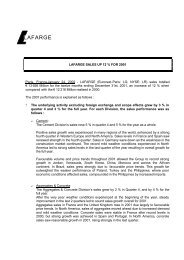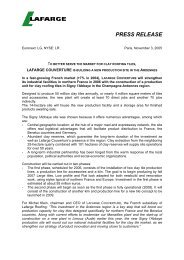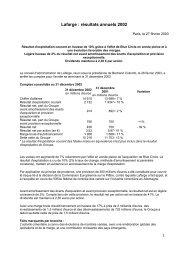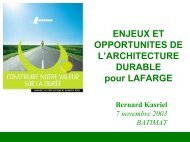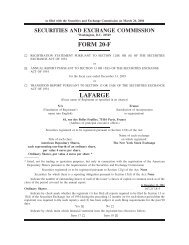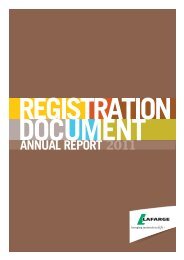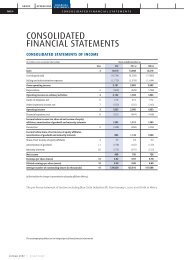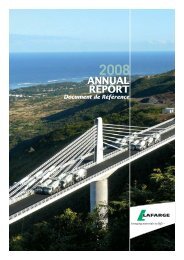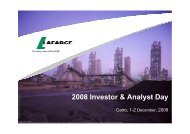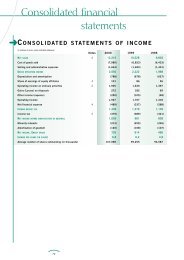The magazine - Lafarge
The magazine - Lafarge
The magazine - Lafarge
Create successful ePaper yourself
Turn your PDF publications into a flip-book with our unique Google optimized e-Paper software.
“ According<br />
to numerous analysts,<br />
the greatest danger<br />
our towns face<br />
is not dispersal<br />
but segregation.”<br />
Manhattan landscape.<br />
Anarchical or mapped<br />
out, how cities develop<br />
is telling of the local<br />
culture.<br />
<strong>The</strong> extended and fragmented city<br />
Today’s towns are growing. Individual houses have multiplied the world’s<br />
urbanized area by four. Changes that are just starting to occur will not<br />
reverse the trend of the phenomenal extension of towns or the waves<br />
of urban populations that are growing every day by some 180 thousand<br />
people!<br />
As Cynthia Ghorra-Gobin notes: “the 20th century underwent major<br />
urban changes: a spreading out accompanied by a loss of centrality<br />
and the emergency of ‘polynuclear’ cities, organized around access<br />
points for express transport.” Indeed, the extended city now raises the<br />
issue of mobility. Temporal proximity is now just as important as spatial<br />
proximity, meaning that urban planning is increasingly concerned with<br />
reducing isolation. <strong>The</strong> issue of accessibility is thus behind the creation<br />
of large urban areas made up of several towns, such as the conurbations<br />
of Ruhr in Germany or Randstad Holland in the Netherlands.<br />
But the inhabitants are not necessarily equal when it comes to accessing<br />
this fluidity. “Certain poor urban populations are now assigned<br />
to land,” points out the geographer. “A town is more than its developments<br />
and buildings, it also defines human groups. According<br />
to numerous analysts, whichever way they develop, by extension<br />
or congestion, there is always a risk of representing social divisions<br />
through geographical segregation.<br />
<strong>The</strong> social fragmentation of urban areas is expressed by the appearance<br />
of urban ghettos and ‘bunker’ neighborhoods, but also by<br />
a segmentation of the residential market – housing for retired people,<br />
students or businesspeople in need of temporary accommodation.<br />
Pushed to the extreme, this leads to the establishment of gated communities.<br />
A product of the need for security and a sense of belonging, the<br />
phenomenon is increasing in the United States where nearly three<br />
P A G E 1 2 | L A FA R G E | N O V E M B E R 2 0 0 7 | C R E S C E N D O<br />
© Getty Images<br />
© ARR © ARR<br />
DJAMEL KLOUCHE AND<br />
CYNTHIA GHORRA-GOBIN<br />
> Architect and urban planner<br />
Djamel Klouche is studying the<br />
constraints of constructing and<br />
reconstructing a town using the<br />
existing town: urban recycling.<br />
He set up the AUC agency in<br />
Paris with Caroline Poulin and<br />
François Decoster.<br />
> Geographer Cynthia Ghorra-<br />
Gobin, research director at<br />
CNRS and professor at the IEP<br />
de Paris and the Sorbonne, is<br />
analyzing the globalization of<br />
the world economy and its<br />
effect upon urban spaces.<br />
EXPLORING A WORLD ON THE MOVE<br />
million homes in twenty thousand 'private towns’ have opted for this<br />
segregating set-up.<br />
Towards a more moderate management of resources<br />
Furthermore, the impact of cities in terms of use of space, ecological<br />
footprint and plundering of natural resources is on the increase.<br />
Towns occupy just 2% of the earth’s surface but consume threequarters<br />
of resources and account for 80% of greenhouse gases.<br />
In response to this situation, three hundred American town mayors<br />
decided to apply the Kyoto Protocol and twenty-seven European urban<br />
planning ministers signed a ‘Charter on Sustainable European Cities’<br />
in May, setting out the main joint actions. Several recent projects, such<br />
as the Dongtan eco-city in China, aspire to become a yardstick for urban<br />
ecology.<br />
New human-scale urban planning<br />
Making the global city sustainable is what supporters of new American<br />
urbanism are proposing. <strong>The</strong> city will be denser, give priority to pedestrians,<br />
favor 'neotraditional’ architecture, provide top quality public<br />
spaces, foster neighborhood relationships and decompartmentalize<br />
residential areas. ‘New urbanism’ is based mainly on the principle that<br />
space is a rare commodity that must be optimized and made denser.<br />
This way of thinking is relatively new on the vast North American continent.<br />
It rethinks the configuration of housing estates and focuses<br />
on public spaces. “Since the middle of the 20th century, urban development<br />
has been characterized by no conceptualization of public spaces,<br />
apart from in historic quarters,” points out Djamel Klouche. <strong>The</strong><br />
enormously increased and deregulated consumption of land is accompanied<br />
by a move away from planning the town and its overall development.<br />
For the last ten to fifteen years we have cast aside this logic.<br />
<strong>The</strong> new urban ‘utopia’ has taken shape in prototypes that have<br />
received a lot of media coverage such as Playa Vista in California and<br />
Seaside in Florida.<br />
<strong>The</strong> political challenges of the town of the future<br />
According to Cynthia Ghorra-Gobin, tomorrow’s challenge will involve<br />
creating ‘metropolitics’: a democratic system at the level of the metropolis,<br />
its labor market area and travel network. “We have to move away<br />
from the idea of competition between towns making up large metropolises,”<br />
she believes. “<strong>The</strong>y behave like competing companies. We need<br />
to devise a new citizenship, on the scale of the metropolis.” A multidisciplinary<br />
approach to urban phenomena is essential: “the urban planner<br />
cannot address the issues the city faces alone (sustainable development,<br />
social segregation, etc.),” concludes Djamel Klouche. “He can<br />
only play a part in it. <strong>The</strong> urban planner’s work must take into account<br />
the opinions of the inhabitants and be part of a democratic process<br />
which will require institutional innovations.”■<br />
C R E S C E N D O | L A FA R G E | N O V E M B E R 2 0 0 7 | P A G E 1 3




